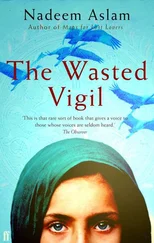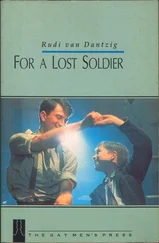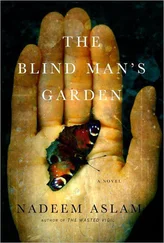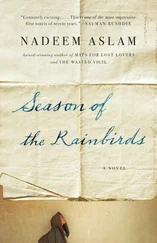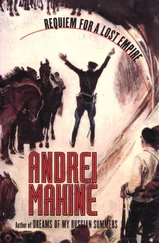“Rape her tonight.”
He goes past Kiran’s house. The sight of the young girl’s flesh — the soft brown body, bright in the sunlight, glimpsed in sections — is hard to shake off. There have been times over the past few years when he has found himself visiting Kiran and her invalid father, but each time he has known— the guilt lying heavy as lead on his thoughts — that he had set out in that direction with the initial intention of encountering and, perhaps, beginning a conversation with, the prostitute who lives next door.
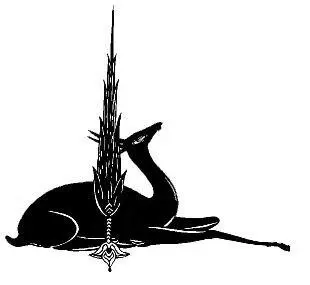

Mah-Jabin’s train, bringing her to Dasht-e-Tanhaii, passes through tunnel after tunnel like a needle picking up beads to thread a rosary. Their number increases as the valley draws near and the ground corrugates to resemble a tempest on land, heaving, convulsing, the troughs deeper with each turn of the rails, the peaks higher in each new view.
And as the air caught between the stiffened waves pours into the compartment — filling it to the brim with England’s warm April — a moth the size and shape of the cursor arrow on a computer screen also enters, to loop and spiral against the window.
She’ll be twenty-seven this year and lives and works in London, divorced from the first cousin she had gone to Pakistan to marry at sixteen, living with him in the pale-green house in Sohni Dharti. Her decision to divorce him had devastated — and enraged — her mother. The two-year marriage is strange to her as though someone is telling her a story.
Kaukab submerges the apples one at a time in the basin of water, rubbing each with her hands to polish away a breach in the slight greasiness on the peel, and then works her way around the fruit until she meets the whistling clean beginning.
The orb of the bunched-up tissue paper in which Mah-Jabin has brought Madonna lilies is continuing to rustle as it expands and opens complicatedly inside the bin out of which dead tulips lean like necks of drunk swans, limp. The Madonnas have replaced them in the glass vase; the shrivelling and the separation of petals that had come to the tulips in drying out has made each cup resemble a live honeysuckle blossom, in size and shape.
“Did you get the flowers I sent you on your birthday, Mother?”
The apples have already begun to yield their fragrance to the warmth in the room, soft and lazy — smoky autumn days. “Yes. They lasted two whole weeks.”
She brings a knife to Mah-Jabin, seeing that she is holding an apple. “Is that how white girls are wearing their hair these days?” Outside, the sun suddenly slips out of a gash in the clouds and lights up the room like magnesium detonated.
Mah-Jabin squints and returns the apple to its hexagonal space among the others, accepts the knife, and gestures with it at the peppers — red as birth — lying on the draining board. “I just felt like a change.” The cutting off is quite recent, and she still finds yard-long strands clinging to the clothes she hasn’t worn for a while.
“It was nearly eighteen-years’ worth of growth.” Kaukab’s lips assume a smile, fixed, as a smiling statue would continue to smile regardless of the violence which might be done to the rest of its face or body. “Eighteen years.”
All the more reason, Mah-Jabin thinks but doesn’t say. Calmly, the blade cuts through the pepper with a hollow sound, creating red hoops that would acquire a wax-like transparency on cooking.
Kaukab nods to postpone the subject, for now. “I saw the peppers by chance yesterday. From Spain, I think. At this time of the year they are the size of tulips so I had to get these big ones when I saw them. A little expensive, but,”—and here she examines the girl’s face for signs of forgetting— “you know your father likes them.”
With the back of her fingers she touches the silk Mah-Jabin has brought her — the green of the dome on Muhammad’s (peace be upon him) mausoleum in sacred Medina — for her to sew a kameez for herself, and which she has rejected because she would not be able to say her prayers in it: it is patterned with butterflies and Islam forbids pictures of living things.
“It is a pity about this,” she says. “Perhaps I could make you a kameez of this, but you probably don’t wear Pakistani clothes these days.” The words are spoken with the back turned; the listener is being tested, to see if she can guess what expression of the face accompanies the words, as a lover would suddenly close both eyes and demand to know what colour they are: the right answer would be a proof of love.
Mah-Jabin was allowed to wear “Western” clothes to school but only if they mirrored shalwar-kameez in cut and style: the shirts had to be long-tailed and had to remain untucked whenever she wore trousers. Aswirl with pleats like the ghagra s of Pakistani desert women, and because it was floor-length, a skirt had been allowed her once, though skirts on the whole were forbidden because they were an easy-access garment. When someone they met at a wedding ceremony was considered “skimpily dressed” by Kaukab, Mah-Jabin had said, “She was wearing a sari! Six and a half yards of fabric.” “The number of yards in itself is immaterial when it comes to modesty,” had been Kaukab’s response. And so she intercepted the secret codes and signals before they could be transmitted and understood. She saw it all as cats’ eyes see in the dark. Despite the fact that Mah-Jabin said she had lost the receipt, she was made to return to the shops a blue sweater that had a broad paler stripe running from armpit to armpit, calling attention to the chest.
Mah-Jabin — chalk-green suede trainers at one end and an uncovered head at the other, black trousers gently fluted at the ankles, and a dazzling purple-collared shirt made out of a marigold sari fabric — brings the plateful of pepper rings flecked with ivory seeds to Kaukab. “I once cooked myself a meal of what my friends at university were about to throw away — the stalks of the peppers, the seeded heart. They were astonished, but you’ve taught me well.” She is afraid of sounding casual about her new familiarities, anxious not to hurt Kaukab by presenting herself to her in any capacity other than a daughter, her daughter. There is so much outside the house that may not be brought into the house, and the mother is quick to construe any voicing of opinion or expression of independent thought by the girl as a direct challenge to her authority.
After almost twenty years of doing without, Kaukab had found a friend when Mah-Jabin reached puberty. “My Allah,” she would say, biting the corner of her veil to stopper her laughter, “I didn’t tell even my mother or mother-in-law half the things you’ve coaxed out of me, you wretch. How can you ask me what was the first thing your father said to me on our wedding night? Have some shame.” They could discuss and dissect anything with ease once Kaukab’s feeble protests against her impropriety had died down.
Mah-Jabin would ask questions about Grandfather Chakor: she wondered why it was not considered strange by the other Muslims at the shrine that the little boy in their midst was uncircumcised, as he must have been because he was born a Hindu. Kaukab explained that during those early days of the century, when disease and infection were rampant, it wasn’t uncommon to find a Muslim boy of that age with his foreskin intact because he was deemed too weak from the smallpox he had caught last year and the typhoid of the year before, and then the cholera the following year would cause yet another postponement: “They circumcised him at that shrine he found himself in, and that was that. In Sohni Dharti there was a twelve -year-old in my time whose mother had eight other children and therefore had never had the time: afterwards he walked around with a hole in the front of his shorts like an elephant in a balaclava, and what am I doing talking to you — and that too of such matters! — when I should be doing something about the bottom of the washing basket where the less-urgent bits and pieces have been lying undisturbed for weeks like an invitation to centipedes and silverfish.”
Читать дальше




